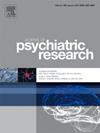Interoception, emotion regulation strategies and skin-picking behaviors – Results of an intensive longitudinal study
IF 3.7
2区 医学
Q1 PSYCHIATRY
引用次数: 0
Abstract
Compulsive skin-picking is associated with emotion regulation difficulties, whose origins remain unclear. Interoception, plays an important role in effective emotion regulation. This study examined the relationship between interoception, emotion regulation strategies, and skin-picking in 136 individuals (85% women, aged 18–41), including 71 engaging in skin-picking and 65 psychologically healthy controls. We were interested in between-group differences in maladaptive and adaptive emotion regulation and aspects of interoception as well as associations of the latter with skin-picking symptoms and use of emotion regulation strategies. At baseline, we assessed habitual emotion regulation strategies (rumination, suppression, distraction, engagement, arousal control, reappraisal) and Interoceptive Sensibility (e.g., emotional awareness, body listening, self-regulation, noticing) through self-report questionnaires. Moreover, Interoceptive Accuracy (IAc) was measured via a Heartbeat Counting Task. Additionally, Ecological Momentary Assessment (EMA) over seven days was used to register use of emotion regulation strategies and the occurrence and severity of skin-picking episodes during that period. At baseline, the skin-picking group exhibited lower IAc, emotional awareness, and higher habitual use of rumination than control group. Lower IAc was associated with higher odds of reporting skin-picking episodes assessed during EMA. Body listening correlated with a reduced sense of control over skin-picking during EMA. In total sample, self-regulation was related to lower odds of using rumination during EMA and noticing with less use of cognitive reappraisal. The study highlights the complex relationship between interoception, emotion regulation, and skin-picking, offering new insights into the mechanisms underlying skin picking disorder.
内感知、情绪调节策略和抠皮行为--一项深入纵向研究的结果。
强迫性抠皮与情绪调节困难有关,其根源尚不清楚。内感知在有效的情绪调节中发挥着重要作用。本研究调查了 136 人(85% 为女性,年龄在 18-41 岁之间)的内感知、情绪调节策略和抠皮之间的关系,其中包括 71 名有抠皮行为的人和 65 名心理健康的对照组。我们关注的是不同群体之间在适应性和适应性情绪调节以及知觉方面的差异,以及知觉与抠皮症状和情绪调节策略使用之间的关联。在基线期,我们通过自我报告问卷评估了习惯性情绪调节策略(反刍、压抑、转移注意力、参与、唤醒控制、重新评估)和知觉敏感性(如情绪意识、身体倾听、自我调节、注意)。此外,还通过 "心跳计数任务 "测量了感知间准确性(IAc)。此外,七天的生态瞬间评估(EMA)用于记录情绪调节策略的使用情况,以及在此期间抠皮事件的发生率和严重程度。与对照组相比,抠皮组在基线时表现出较低的IAc、情绪意识和习惯性反刍。较低的 IAc 与在 EMA 评估期间报告抠皮事件的几率较高有关。身体倾听与 EMA 期间对抠皮的控制感降低有关。在所有样本中,自我调节与在 EMA 期间使用反刍的几率较低有关,也与较少使用认知再评价有关。这项研究强调了内感知、情绪调节和抠皮之间的复杂关系,为了解抠皮障碍的内在机制提供了新的视角。
本文章由计算机程序翻译,如有差异,请以英文原文为准。
求助全文
约1分钟内获得全文
求助全文
来源期刊

Journal of psychiatric research
医学-精神病学
CiteScore
7.30
自引率
2.10%
发文量
622
审稿时长
130 days
期刊介绍:
Founded in 1961 to report on the latest work in psychiatry and cognate disciplines, the Journal of Psychiatric Research is dedicated to innovative and timely studies of four important areas of research:
(1) clinical studies of all disciplines relating to psychiatric illness, as well as normal human behaviour, including biochemical, physiological, genetic, environmental, social, psychological and epidemiological factors;
(2) basic studies pertaining to psychiatry in such fields as neuropsychopharmacology, neuroendocrinology, electrophysiology, genetics, experimental psychology and epidemiology;
(3) the growing application of clinical laboratory techniques in psychiatry, including imagery and spectroscopy of the brain, molecular biology and computer sciences;
 求助内容:
求助内容: 应助结果提醒方式:
应助结果提醒方式:


